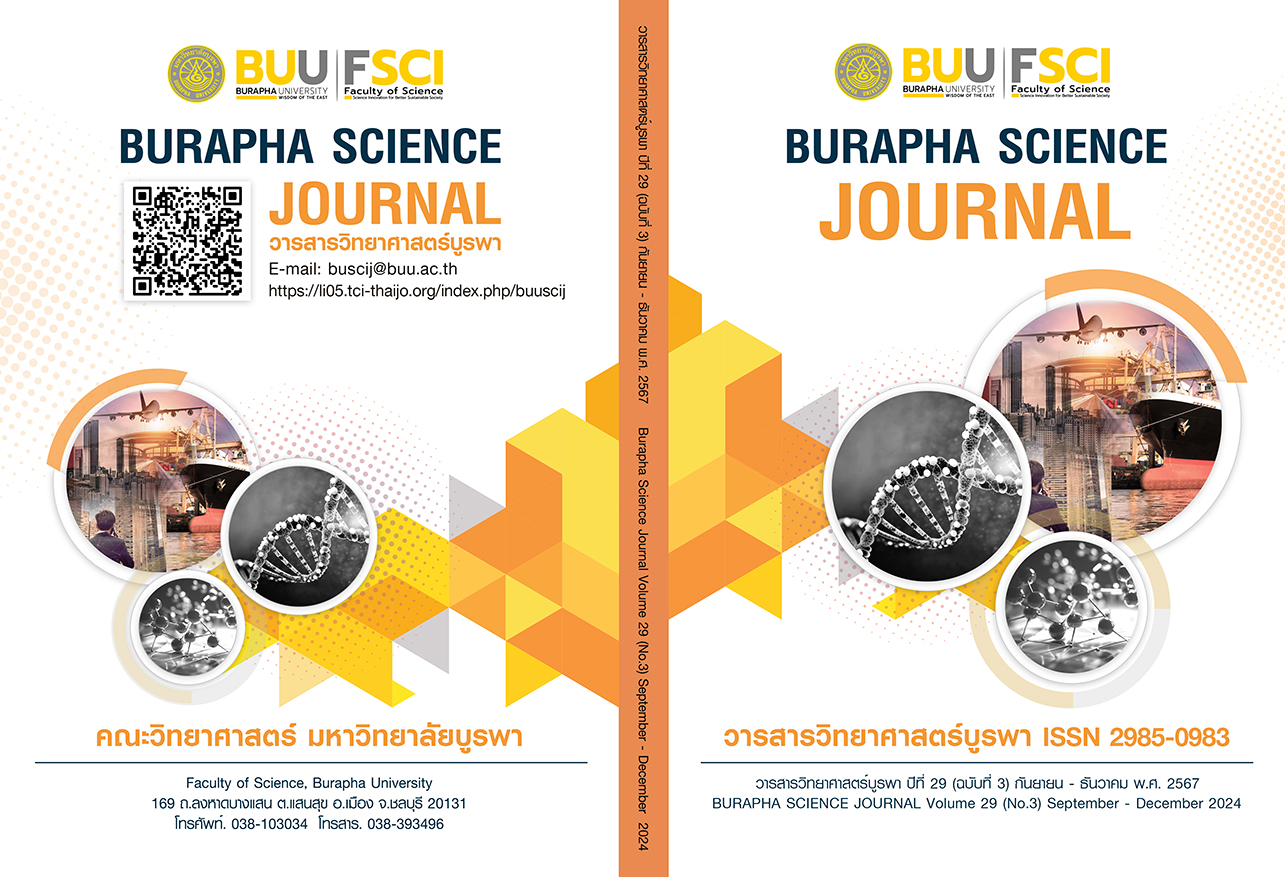ผลของการเตรียมพร้อมเมล็ดพันธุ์พริกขี้หนูสวน (Capsicum frutescens L.) ให้ทนเค็มด้วยสารเคมีต่างชนิดและระยะเวลาการแช่ที่แตกต่างกันต่อการเจริญเติบโต ผลผลิต ลักษณะทางสรีรวิทยาบางประการ และปริมาณสารสำคัญ
คำสำคัญ:
การเตรียมพร้อมเมล็ดพันธุ์ , พริก, ทนเค็ม , Acetylsalicylic acidบทคัดย่อ
วัตถุประสงค์และที่มา : ดินเค็มมีผลต่อการเจริญเติบโตและผลผลิตของพืช โดยเฉพาะอย่างยิ่งพริกขี้หนูสวน (Capsicum frutescens L.)ที่จัดเป็นพืชกลุ่มไกลโคไฟต์ซึ่งไม่สามารถเจริญเติบโตได้ภายใต้ความเค็มสูง งานวิจัยนี้จึงมีวัตถุประสงค์เพื่อศึกษาผลของการเตรียมพร้อมเมล็ดพันธุ์พริกขี้หนูสวนด้วยการใช้สารเคมีและระยะเวลาการแช่สารที่แตกต่างกันต่อการเจริญเติบโต ผลผลิต ลักษณะทางสรีรวิทยาบางประการ และปริมาณสารสำคัญของพริกขี้หนูสวนภายใต้ความเครียดจากความเค็ม
วิธีดำเนินการวิจัย : วางแผนการทดลองแบบสุ่มสมบูรณ์ การทดลองที่ 1 มีจำนวน 32 ทรีทเมนต์ ๆ ละ 4 ซ้ำ ๆ ละ 50 เมล็ด โดยนำเมล็ดพริกขี้หนูสวนมาเตรียมความพร้อมด้วยการแช่ใน RO water, NaCl เข้มข้น 20 mM, CaCl2 เข้มข้น 10 mM, Acetylsalicylic acid (ASA) เข้มข้น 0.2 mM และ Glycine betaine (GB) เข้มข้น 25 mM นาน 12-48 ชั่วโมง หรือไม่ได้ผ่านกระบวนการเตรียมเมล็ดพันธุ์ จากนั้นนำเมล็ดเหล่านี้ไปปลูกในสภาวะปกติหรือสภาวะที่มีความเครียดจากความเค็ม (50 mM NaCl) เพื่อทดสอบเปอร์เซ็นต์ความงอกของเมล็ดและเวลาเฉลี่ยในการงอกของเมล็ด การทดลองที่ 2 และ 3 มีจำนวน 5 ทรีทเมนต์ ๆ ละ 4 ซ้ำ โดยนำเมล็ดพริกขี้หนูสวนมาเตรียมความพร้อมด้วยการแช่ในสารเคมี ตลอดจนปลูกเมล็ดพริกขี้หนูสวนในสภาวะเช่นเดียวกับการทดลองที่ 1
ผลการวิจัย : การเตรียมพร้อมเมล็ดพันธุ์พริกขี้หนูสวนด้วย NaCl เข้มข้น 20 mM เป็นเวลา 12 ชั่วโมง, CaCl2 เข้มข้น 10 mM เป็นเวลา 24 ชั่วโมง, ASA เข้มข้น 0.2 mM เป็นเวลา 48 ชั่วโมง และ GB เข้มข้น 25 mM เป็นเวลา 24 ชั่วโมง ช่วยเพิ่มการงอกของเมล็ด ทั้งยังทำให้เมล็ดที่ปลูกในสภาวะที่มีความเครียดจากความเค็มยังคงอัตราการงอกที่สูง และมีเวลาเฉลี่ยในการงอกที่ใกล้เคียงกับการปลูกในสภาวะที่ไม่มีสารละลายเกลือ สำหรับการศึกษาที่ระยะการเจริญเติบโตทางด้านลำต้นและใบ และระยะการเจริญเติบโตทางด้านการสืบพันธุ์ พบว่าต้นพริกขี้หนูสวนที่เจริญมาจากเมล็ดซึ่งแช่ด้วย ASA เข้มข้น 0.2 mM เป็นเวลา 48 ชั่วโมง มีการเจริญเติบโต องค์ประกอบของผลผลิตและผลผลิต ลักษณะทางสรีรวิทยาบางประการ และปริมาณสารสำคัญของต้นที่เจริญในสภาวะปกติหรือสภาวะที่มีความเค็มสูงที่ใกล้เคียงกัน
สรุปผลการวิจัย : การเตรียมพร้อมเมล็ดพันธุ์พริกขี้หนูสวนให้ทนเค็มด้วย ASA ความเข้มข้น 0.2 mM เป็นเวลา 48 ชั่วโมง เป็นวิธีที่เหมาะสมที่สุดในการศึกษานี้เนื่องจากทำให้การเจริญเติบโต องค์ประกอบของผลผลิตและผลผลิต ลักษณะทางสรีรวิทยาบางประการ และปริมาณสารสำคัญ ที่ระยะการงอก ระยะการเจริญเติบโตทางด้านลำต้นและใบ และระยะการเจริญเติบโตทางด้านการสืบพันธุ์ของต้นพืชที่โตภายใต้สภาวะความเค็มสูงมีค่าที่ไม่แตกต่างอย่างมีนัยสำคัญทางสถิติกับต้นพืชที่โตในสภาวะปกติ
เอกสารอ้างอิง
Ahmet, K., Rauf, S., Ferit, K., Özlem, D., & Ali, R.D. (2012). Alleviation of salt-induced adverse effects in pepper seedlings by seed application of glycine betaine. Scientia Horticulturae, 148, 197-205.
Ali, R.M., & Abbas, H.M. (2003). Response of salt stressed barley seedlings to phenylurea. Plant, Soil and Environment, 49, 158-62.
Aloui, H., Souguir, M., Latique, S., & Hannachi, C. (2014). Germination and growth in control and primed seeds of pepper as affected by salt stress. Cercetari agronomice în Moldova, 47(3), 83-95.
Arfan, M., Habib, A., & Ashraf, M. (2007). Does exogenous application of salicylic acid through the rooting medium modulate growth and photosynthetic capacity in two differently adapted spring wheat cultivars under salt stress. Journal of Plant Physiology, 164(6), 685-694.
Arunin, S. (1996). Saline soil in Thailand. Bangkok: Ministry of Agriculture and Cooperatives.
Ayaz, F.A., Kadioglu, A., & Urgut, R.T. (2000). Water stress effects on the content of low molecular weight carbohydrates and phenolic acids in Ctenanthe setosa. Canadian Journal of Plant Science, 80, 373-378.
Baskar, R., Shrisakthi, S., Sathyapriya, B., Sathyapriya, R., Nithya, R., & Poongodi, P. (2011). Antioxidant potential of peel extracts of banana varieties (Musa sapientum). Food and Nutrition Sciences, 2, 1128-1133.
Bewley, J.D., & Black, M. (1978). Physiology and Biochemistry of Seeds in Relation to Germination. Berlin: Springer Verlag.
Bradford, K.J. (1986). Manipulation of seed water relation via osmotic priming to improve germination under stress condition. HortScience, 21, 1105-1112.
Cachorro, P., Ortiz, A., &Cerda, A. (1994). Implications of Calcium Nutrition on the Response of Phaseolus vulgaris L. to Salinity. Plant Soil, 159, 205-212.
Cano, E.A., Bolarin, M.C., Perez-Alfocea, F., & Caro, M. (1991). Effect of NaCl priming on increased salt tolerance in tomato. Journal of Horticultural Science, 66, 621-628.
Chanprasert, W. (1995). Seed technology. Bangkok: Department of Agronomy, Faculty of Agriculture, Kasetsart University. (in Thai)
Chuamnakthong, S., Nampei, M., & Ueda, A. (2019). Characterization of Na+ exclusion mechanism in rice under saline-alkaline stress conditions. Plant Science, 287, 110-117.
Collin, M.D., Liode, M.W., & Paul, W.B. (1995). Improved method for quantifying capsaicinoids in capsicum using high-performance liquid chromatography. HortScience, 30(1), 137-139.
Copeland, L.O., & McDonald, M.B. (1995). Seed science and technology. New York : Chapman & Hill.
Djebar, A., Berrebbah, H., & Djebar, M.R. (2020). Exogenous acetyl salicylic acid (aspirin) effects on stress tolerance during seed germination of Triticum durum DESF. Studia Universitatis Vasile Goldis Seria Stiintele Vietii (Life Sciences Series), 30(1), 6-12.
Duangpatra, P. (1995). Principles and methods for using chemical fertilizers. Bangkok: Department of Soil Science, Faculty of Agriculture, Kasetsart University. (in Thai)
Ellis, R.H.,&E.H. Roberts. (1980). Improved equation for the prediction of seed longevity. Annals of Botany, 45, 13-30.
Elsawy, H.I.A., Mekawy, A.M.M., Elhity, M.A., Abdel-dayem, S.M., Abdelaziz, M.N., Assaha, D.V., Ueda, A., & Saneoka, H. (2018). Differential responses of two Egyptian barley (Hordeum vulgare L.) cultivars to salt stress. Plant Physiology and Biochemistry, 127, 425-435.
Falcinelli, B., Sileoni, V., Marconi, O., Perretti, G., Quinet, M., Lutts, S., & Benincasa, P. (2017). Germination under moderate salinity increases phenolic content and antioxidant activity in rapeseed (Brassica napus var oleifera Del.) sprouts. Molecules, 22, 1377.
Farooq, M., Basra, S.M.A., Saleem, B.A., Nafees, M., & Chishti, S.A. (2005). Enhancement of tomato seed germination and seedling vigour by osmopriming. Pakistan Journal of Agricultural Sciences, 42(3-4), 36-41.
Fuleki, T., & Francis, F.J. (1968). Quantitative methods for anthocyanins, extraction and determination of total anthocyanin in cranberries. Journal of food science, 33, 72.
Hadas, A. (1977). Water uptake and germination of leguminous seeds in soils of changing matrix and osmotic water potential. Journal of Experimental Botany, 28, 977-985.
Heydecker, W., & Coolbear, P. (1977). Seed treatments for improved performance-survey and attempted prognosis. Seed Science and Technology, 5, 353-425.
Hydro-Informatics Institute. (2017). Thailand water situation in 2017. Bangkok: Hydro-Informatics Institute, Ministry of Science and Technology. (in Thai)
International Seed Testing Association. (1996). International rules for seed testing. Switzerland: Bassersdorf.
International Seed Testing Association. (2014). International rules for seed testing. Switzerland: Bassersdorf.
Im-erb, A. (1999). Guidelines for improving the chemical quality of soil in Thailand. Land Development Journal, 36(372), 24-36. (in Thai)
Kameswari, P.L., & Manohar, P.D. (2005). Evaluation of chili genotypes for salt tolerance. Indian Journal of Horticulture, 62(1), 46-48.
Khan, H.A., Ayub, C.M., Pervez, M.A., Bilal, R.M., Shahid, M.A., & Ziaf, K. (2009). Effect of seed priming with NaCl on salinity tolerance of hot pepper (Capsicum annuum L.) at seedling stage. Soil Environment, 28(1), 81-87.
Korkmaz, A., Irikçi, S., Kocaçınar, R., Deger, F.O., & Demirkırıan, A.R. (2012). Alleviation of salt-induced adverse effects in pepper seedlings by seed application of glycine betaine. Scientia Horticulturae, 148, 197-205.
Kunlanit, B. (2018). Laboratory manual for the subject of soil fertility and fertilizer. Mahasarakham: Department of Agricultural Technology, Faculty of Technology, Mahasarakham University. (in Thai)
Laloknam, S., Sirisopana, S., Limchoovong, S., Phornphisutthimas, S., Kosiarpa, T., Areeyadej, W., Puangkwan, P., & Nilapai, Y. (2008)a. Betaine, glycerol, and proline enhance seed germination and plant growth of mung bean (Vigna radiate L.) under high salinity. In The 34th Congress on Science and Technology of Thailand. Thailand: The Science Society of Thailand Under the Patronage of His Majesty the King.
Laloknam, S., Suksanchananun, C., Phornphi-sutthimas, S., Sirisopana, S., Limchoo-wong, S., & Rai, V. (2008)b. Reduction of salt stress in onion root by glycerol, betaine and proline. In The 4th Naresuan Research Conference. Thailand: Naresuan University.
Land Classification Division and FAO Project Staff. (1973). Soil interpretation handbook for Thailand. Bangkok: Department of Land Development, Ministry of Agriculture and Cooperatives.
Land Development Department. (2010). Manual for the process of chemical soil analysis: Methods for analyzing the cation exchange capacity of soil. Bangkok: Land Development Department. (in Thai)
Landon, J.R. (1991). Booker tropical soil manual: a handbook for soil survey and agricultural land evaluation in the tropics and subtropics. England: Harlow, Essex.
Mahajan, S., & Tuteja, N. (2005). Cold, salinity and drought stresses: An overview. Archives of Biochemistry and Biophysics, 444, 139-58.
Metropolitan Waterworks Authority. (2019). Real time water quality monitoring system project. Bangkok: Metropolitan Waterworks Authority. (in Thai)
Mir, R.A., & Somasundaram, R. (2021). Salicylic acid and salt stress tolerance in plants: a review. Journal of Stress Physiology & Biochemistry, 17(3), 32-50.
Porra, R., Thompson, W., & Kriedemann, P. (1989). Determination of accurate extinction coefficients and simultaneous equations for assaying chlorophylls a and b extracted with four different solvents: verification of the concentration of chlorophyll standards by atomic absorption spectroscopy. Biochimica et Biophysica Acta, 975, 384-394.
Prapanoppasin, P. (1999). Studies on Pepper Seed Priming by Hydropriming and Osmo-conditioning. Bangkok: Kasetsart University. (in Thai)
Rivas, M., Sundstorm, F.J., & Edwards, R.L. (1984). Germination and crop development of hot pepper after seed priming. HortScience, 19, 279-281.
Royal Irrigation Department. (2016). Report on surveillance and monitoring of water quality regarding salinity No. 30/2016. Bangkok: Royal Irrigation Department, Ministry of Agriculture and Cooperatives. (in Thai)
Saffan, S.E.S. (2008). Effect of salinity and osmotic stresses on some economic plants. Research Journal of Agriculture and Biological Sciences, 4(2), 159-166.
Senaratna, T., Touchell, D., Bumm, E., & Sixon, K. (2000). Acetyl salicylic and salicylic acid induced multiple stress tolerance in bean and tomato plants. Plant Growth Regulation, 30, 157-161.
Siviritepe, H.O., & Dourado, A.M. (1995). The effect of priming treatments on the viability and accumulation of chromosomal damage in aged pea seeds. Annual Botany, 75, 165-171.
Soil Survey Division Staff. (1993). Key to soil survey manual. Washington D.C.: U.S. Department of Agriculture, Printing Office.
Sonsri, K., Phankamolsil, N., Karuna, S., Thaymuang, W., & Phankamolsil, Y. (2020). Sea level rise influence on soil salinity variability in agricultural areas, Pathum Thani Province. Khon Kaen Agriculture Journal, 48(5), 1028-1041. (in Thai)
Techawongstien, S. (2007). The potential of chili production for the Thai export industry at present and in the future. Khon Kaen: Faculty of Agriculture Khon Kaen University. (in Thai)
U.S. Salinity Laboratory Staff. (1954). Diagnosis and improvement of saline and alkali soils: Handbook No. 60. Washington, D.C.: U.S. Department of Agriculture, USA.
Xu, L., Chen, H., Zhang, T., Deng, Y., Yan, J., & Wang, L. (2022). Salicylic acid improves the salt tolerance capacity of Saponaria officinalis by modulating its photosynthetic rate, osmoprotectants, antioxidant levels, and ion homeostasis. Agronomy, 12(6), 1443.
ดาวน์โหลด
เผยแพร่แล้ว
รูปแบบการอ้างอิง
ฉบับ
ประเภทบทความ
สัญญาอนุญาต
ลิขสิทธิ์ (c) 2024 คณะวิทยาศาสตร์ มหาวิทยาลัยบูรพา

อนุญาตภายใต้เงื่อนไข Creative Commons Attribution-NonCommercial-NoDerivatives 4.0 International License.
Burapha Science Journal is licensed under a Creative Commons Attribution-NonCommercial-NoDerivatives 4.0 International (CC BY-NC-ND 4.0) licence, unless otherwise stated. Please read our Policies page for more information



